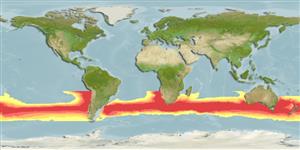>
Scombriformes (Mackerels) >
Scombridae (Mackerels, tunas, bonitos) > Gasterochismatinae
Etymology: Gasterochisma: Greek, gaster = stomach + Greek, chiasma = marked with the sign of "X" (Ref. 45335).
More on author: Richardson.
Environment: milieu / climate zone / depth range / distribution range
Οικολογία
Θαλασσινό(ά); ωκεανόδρομο(ς) (Ref. 51243); εύρος βάθους 200 - ? m (Ref. 9563). Subtropical; 8°C - 15°C (Ref. 168); 19°S - 55°S, 180°W - 180°E (Ref. 168)
Circumglobal in southern temperate waters.
Μέγεθος / Βάρος / Age
Maturity: Lm ? range ? - ? cm
Max length : 164 cm FL αρσενικό/απροσδιόριστο; (Ref. 168)
Short description
Κλείδες προσδιορισμού | Μορφολογία | Μορφομετρία
Ραχιαίες άκανθες (συνολικά) : 17 - 18; Μαλακές ραχιαίες ακτίνες (συνολικά) : 9 - 12; Εδρικές άκανθες: 0; Μαλακές εδρικές ακτίνες: 11 - 13; Σπόνδυλοι: 44. Pelvic fins enormous in juveniles, longer than head length. Pelvic fins fitting into a deep ventral groove at all sizes. Interpelvic process tiny and bifid. No anterior corselet. Swim bladder present with two anterior projections that extend into the back of the skull. The morphological adaptations required for maintaining high brain and retinal temperatures are discussed in Ref. 11221.
Occurs in deep oceanic waters (Ref. 9563), most abundant in waters of 8° to 10°C. Stomach contents of the specimen from north of the Hawaiian Archipelago include onychoteuthids, ommastrephid squid, vertebrae and fin rays from an unidentified fish, bird feathers and parasitic nematodes (Ref. 11006). Taken as longline by-catch by Japanese fishing for Thunnus maccoyii.
Life cycle and mating behavior
Γεννητική Ωρίμανση | Αναπαραγωγή | Γεννοβολία | Αβγά | Γονιμότητα | Προνύμφες
Collette, B.B. and C.E. Nauen, 1983. FAO Species Catalogue. Vol. 2. Scombrids of the world. An annotated and illustrated catalogue of tunas, mackerels, bonitos and related species known to date. Rome: FAO. FAO Fish. Synop. 125(2):137 p. (Ref. 168)
IUCN Red List Status (Ref. 130435: Version 2024-1)
Threat to humans
Harmless
Human uses
αλιεία: περιορισμένης εμπορικότητας; αλιεία αναψυχής: ναί
Εργαλεία
Special reports
Download XML
Διαδικτυακές πηγές
Estimates based on models
Preferred temperature (Ref.
123201): 10.2 - 15.9, mean 11.7 °C (based on 22 cells).
Phylogenetic diversity index (Ref.
82804): PD
50 = 1.0000 [Uniqueness, from 0.5 = low to 2.0 = high].
Bayesian length-weight: a=0.01122 (0.00514 - 0.02450), b=3.04 (2.87 - 3.21), in cm total length, based on all LWR estimates for this body shape (Ref.
93245).
Τροφικό Επίπεδο (Ref.
69278): 4.4 ±0.57 se; based on food items.
Ελαστικότητα (Ref.
120179): Μεσαίο(α), ελάχιστος χρόνος για διπλασιασμό πληθυσμού 1,4 - 4,4 έτη (Preliminary K or Fecundity.).
Fishing Vulnerability (Ref.
59153): Very high vulnerability (90 of 100).
Nutrients (Ref.
124155): Calcium = 28.4 [15.9, 50.2] mg/100g; Iron = 1.3 [0.8, 2.2] mg/100g; Protein = 22.7 [20.5, 24.6] %; Omega3 = 0.397 [0.256, 0.622] g/100g; Selenium = 35.7 [20.8, 64.7] μg/100g; VitaminA = 11.5 [4.4, 31.5] μg/100g; Zinc = 0.443 [0.319, 0.627] mg/100g (wet weight); based on
nutrient studies.
